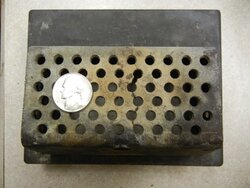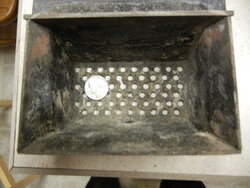After a complete cleaning of an Elena that I purchased used, the only thing needing attention is the bottom of the burn pot is getting brittle and cracking. See photos


1. I can attach a support plate to the bottom with matching but slightly larger holes to not restrict air flow.
2. What type of material should I try?


1. I can attach a support plate to the bottom with matching but slightly larger holes to not restrict air flow.
2. What type of material should I try?



 (couldn't resist!) I know rapid cooling is used to harden steel but wondered if it helped create the problem.
(couldn't resist!) I know rapid cooling is used to harden steel but wondered if it helped create the problem.  ). Hmmm....
). Hmmm....